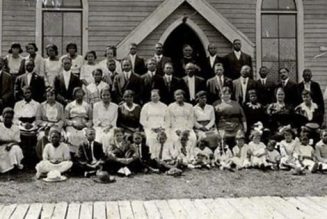
[Editor’s Note: this excerpt is taken from chapter 5 of Meaning at the Movies: Becoming a Discerning Viewer, by Grant Horner (Crossway Books).]
Film, Fear, Pleasure
Most people would not describe fear as a pleasant emotion. The experience of terror, of being threatened, doomed, or on the brink of feeling some terrible agony, is quite naturally a negative feeling. The purpose of fear is to serve as a warning. People do not send chocolates or flowers as a warning. A tiger does not purr before he attacks you, nor does your heart beat more slowly right before he eats you. So why is there a massive industry dedicated to the production of fear for pleasure? Scary movies, skydiving and bungee-jumping, haunted houses on Halloween, and horror novels combine to make a multibillion dollar economic powerhouse. Why?
Fear for pleasure may have murky roots historically, but we do know that with the rise of the Gothic novel in the late eighteenth and early nineteenth centuries, Western culture became fascinated with the sensation of terror. This coincides with both the Terror of the French Revolution and the rise of newsprint and what we now call “mass media.” In other words, everyone knew about the great French Terror and its central object of fascination: le guillotine. And let’s face it—news of suffering is as fascinating as it is repellent. Gothicism in literature and art in some ways was closely related to the Romanticism movement of the same period. Both were fascinated by powerful emotion, the wildness of nature, the strangeness of the supernatural, and the power of the sublime, which could transport you out of your own present consciousness. These Gothic novels—lurid tales about nuns being raped by cardinals in convents, young girls being carried off to moldering castles followed by enforced marriages to moldering old men after their fortunes, and of course tales of vampires as well as mortals who live a good life by day and another life by night—were forbidden reading in polite society.
They were thus wildly popular.
Frightening movies have always been a major segment of Hollywood fare. Fear sells tickets. Perhaps the greatest irony about scary movies is that one of our greatest and most universal human fears is a fear of the dark (which is really a fear of the unknown). So, really—”horror” plus “film” is a natural, you see. Movie theaters display their wares in the dark.
What You Are So Afraid Of?
The grounding premise of this book is that fallen humans suppress certain basic truths about God and his universe. This takes many forms: we suppress an inbuilt sense of his existence, we suppress whatever evidence for his existence may come our way, we suppress the witness of conscience by supplying alternative explanations for its annoying presence, and we suppress knowledge of our own natures, telling ourselves that we are either inherently good, or that some people are good and some are bad, or that morality is an illusion. The final willful act of suppression is that we suppress the fact of suppression itself. We tell ourselves that all we want is the truth, when that is the last thing we actually accept. But truth cannot be suppressed entirely, perfectly, or permanently, and it “bubbles back up,” resurfacing as reconstituted core elements of cultural production. I want to again clarify that we cannot make a one-to-one mapping here—culture is not just a directly reconfigured diagram of truth. It is not a Lego building that has been partly dismantled and then rebuilt. Culture is far more complex than this, and I am not at all sure its mystery can fully be unraveled. Rather, I am saying that the recognition of truth elements in cultural artifacts helps us do two things: we can better interpret and understand our culture, and we can see that even rebellious human culture demonstrates to us that we are exactly as God says we are.
The strange conjunction of fear for pleasure is rarely considered, at least in a theological framework. Fear is basic to human psychological nature. While I see no point in denying that fear has a number of purposes, including self-preservation, I don’t think the usual explanations about the origins of fear can quite explain why we also find certain kinds of pleasure in an emotion that is not, in fact, pleasant.
Fear is perhaps the most difficult feeling to suppress; “it will out,” just like truth. Many suspenseful film scenes are built on our knowledge of this fact, as when we are empathetically frightened for a character hiding in a closet while a dangerous killer searches the room. Letting the fear express itself, as either a whimper or a scream, will bring about the feared end—the killer will hear and strike. Silence— suppression—is safety. But self-control while fearful is no easy task. In 1959 a rather low-grade film whipped up quite a marketing frenzy based upon this knowledge. The Tingler has a silly plot involving a scientific discovery that fear is actually embodied in a parasitic organism that attaches to the spine; when your spine tingles, the only way to get rid of the parasite is to scream. If you hold in the scream, you will die of fear. The marketing gimmick involved installing vibrating buzzers in random theater seats without audience knowledge. Near the end of the film, this “tingler” creature escapes into a movie theater. Then it looks like the film “breaks” in the projector, and we see the shadow of the “tingler” crawling across the lens—and then the screen (the real one) goes black. The “tingler” has escaped from the movie. The audience is now in total darkness. A voice from the soundtrack cries out that the “tingler” is in this theater, and you’d better scream to save your life—and that’s when the seat-buzzers go off. Movie world and real world meet unexpectedly and everyone dumps their Cokes and greasy popcorn buckets on their dates. The high-decibel response to the gimmick, as you might imagine, had a galvanizing effect on the next audience waiting in line outside, tickets in hand.
There are really only two categorical objects of fear: fear of the natural world and fear of the supernatural world. There is indeed much to fear in the natural world, and these objects of fear make their way into many movies, such as The Birds and Jaws. There is also fear of the unknown, the “super” natural—the things “above” the natural, material world—and of course many horror films are built upon this fear. The supernatural is terrifying because the extent of its power cannot be predicted. Almost all fears can be reduced to a fear of the unknown, including the fear of not knowing what is going to happen next. Uncertainty is, quite literally, dreadful. This is what drives the greatest moments of suspense and terror in movies. It is not the knowing—it is the not knowing. The two categorical objects of fear meet in the one great universal fear—the one fear that is widely observable in the natural world, but holds open the door to the supernatural one. That universal fear is death.
We have an inborn ability to experience the warnings of fear when in the presence of natural dangers. For people like me who climb mountains and cliffs as a sport, part of the challenge is learning to control the extremely powerful natural fear response to danger. What is more interesting, however, is the response that apparently all humans have in the face of a supernatural force, real or imagined.3 Even people who are strict materialists and do not believe in anything beyond the natural, observable material world can easily be frightened by a movie with an effectively presented supernatural element. You know it is a movie; you know it is fiction; you know these things aren’t real. Yet your heart pounds and you jump during the scary moments. Why? There isn’t always a buzzer under the seat.
I don’t think it is just because of a suspenseful plot. I think all of us share a vague recognition, or at least a suspicion, that there may be more to the world than meets the eye. One of Hamlet’s most famous lines in Shakespeare’s play addresses this three-way confrontation between skepticism, uncertainty, and belief: “There are more things in heaven and earth, Horatio, than are dreamt of in your philosophy.”4 In fact, I believe there is much more. I also believe that part of the fallen human condition is that this knowledge is strongly suppressed, and in turn the suppression itself is suppressed. As a result of the conservation of truth principle, however, we enforce a double movement that overturns this very suppression: first, we make fiction, including movies, featuring supernatural elements; second, we often find these fictions terrifying, even though we believe they are fiction. It has long been said that art imitates life even as life imitates art. I would add to that. We do not believe our not believing.5 Our fiction imitates and undermines the fiction of our unbelief.
It is indeed a strange truth about humanity that we tell ourselves stories that bring about the negative and uncomfortable emotion of fear. Yet—perhaps—not so strange. The actual psychological processes of deliberately induced fear are worth considering. Anytime we watch a movie, we manage quite an amazing feat. On the one hand, we know that what we are experiencing is fiction; it is carefully constructed, produced, and presented as if it is naturally occurring in our conscious experience of the real world.6 This is why effective movies “transport” us, like all great art, as Longinus taught two thousand years ago. When you’re watching a really well-made film, you don’t realize that this is what you’re doing, at least not in the forefront of your consciousness. But at the same time you do realize what you’re doing. In other words, your mind does double-duty; you in a certain sense become two persons—one grounded in reality, one in fantasy. This book deals with this phenomenon differently based upon different genres and specific movies, but perhaps the most interesting question we can ask is, what happens when we enter the filmic creation of fear, which terrifies us even when we know it is not real?
In order to answer this question, we need to consider one more kind of fear, as yet unmentioned. This is the fear of God. There are two kinds of fear regarding God: the reverential trust, awe, and fear of giving offense that characterizes believers and the fear of those who do not believe—their fear that they might be wrong. A variation of the second fear can be seen in the person who is sure there is a God of some kind but does not want to follow him and thus lives in fear of judgment, however vague that fear may be. I believe the present fallen state of man is such that our previously natural fear of God—awe, respect, submission, and fear of offending—has been blunted, suppressed, and reduced. It has changed its object, to be precise. Instead of fearing God, we fear any number of other things, whereas if we feared God rightly we would fear nothing else wrongly.
If there is a God, one whom we naturally (and rightly) should fear; and if we have suppressed this truth, as Romans 1 says we have; and if, as I am arguing in this book, powerful truths such as these cannot and do not remain suppressed, then perhaps we now have a way of understanding the business and art of fear for pleasure. If God (and fear of him) has been removed from the forefront of our conscious minds, yet we are “built to fear” something infinitely greater than ourselves, something awesome, terrifying, mysterious, and incomprehensible, then we find ourselves predisposed to replace fear of him with fear of something.7
The full-blown abject terror of an infinite God—unmediated by grace—would be overwhelming and impossible to bear. And try as we might, we cannot entirely vanquish our sense of God or our creeping fears regarding him. The fear is inescapable. It is also unbearable. The only thing we can do is develop techniques to cope with the fear, just like a mountain climber or a skydiver does. The fear has to be managed— it has to be controlled. Uncontrolled fear is crippling. I believe that one way this management can be undertaken (and it can be done very effectively) is through storytelling. Fiction is a management tool through which suppressed truths slowly reemerge in bits and pieces, chunks and tatters, despite our attempts to bury the way the world really is. Narrative in general, and the very powerful, reality-replacing narrative art of film, can present to us an entirely convincing object of fear that has nevertheless been controlled, tamed, and reduced to a manageable package. One moment we are petrified in the dark theater—the next we are walking to the coffee shop laughing with our friends. Not so with deity.
What does the Bible say about the fear of God? The concept of “the fear of the Lord” is widely misunderstood, even by many Christians. It is quite often mocked by those who do not believe and who think that believers feel like I did while watching late-night scary movies as a kid. But this understanding is not at all accurate. The fear of God is taught everywhere in Scripture, and it is a fairly simple idea that we find consistently in all parts of the Old and New Testaments. The psalmist teaches that “the fear of the LORD is the beginning of wisdom; all those who practice it have a good understanding . . .” (Ps. 111:10). Wisdom—not to be confused with intelligence or knowledge, though they are all interrelated—begins only with a rightly reverential awe and respect for God, as well as a fear of offending him. Fearing God always features this moral and ethical component: “by the fear of the LORD one turns away from evil” (Prov. 16:6). Fear of God, repentance, and slow but steady moral growth are intimately bound up together. “Behold, the fear of the LORD, that is wisdom, and to turn away from evil is understanding” (Job 28:28). Refusing to fear God is the clearest marker of a foolish person, according to Solomon: “The fear of the LORD is the beginning of knowledge; fools despise wisdom and instruction” (Prov. 1:7).
Paradoxically, the God who is worthy of fear promises those who trust in him that they do not need to be afraid of him in the normal, fallen sense. God’s words of comfort to Abraham in Genesis 15:1 are typical: “Fear not, Abram, I am your shield. . . .” There is marvelous irony here. The one thing in the universe we really should fear— God—protects us from himself by enacting his grace for our benefit and his glory. Thus, if you fear him you have no need to be afraid. If you do not fear him you have every reason to be afraid. The most frightening verse in all of Scripture is Hebrews 10:31: “It is a fearful thing to fall into the hands of the living God.” What God asks is more than reasonable and in fact becomes easier the more we trust in him. He asks that we respond only as we should, with awe, respect, and obedience in the face of his sublimity, his infinity, his power, and his holiness. If we do not do that, then we find ourselves living enslaved to various other fears, none of which is pleasant.
For a believer, fearing God is a sublime, deep pleasure. That is what the ultimate fear is—pleasurable. It is not supposed to be negative, uncomfortable, or debilitating, but rather edifying by showing us who and what we are in terms of an almighty and infinite being. The fear of God, ironically, is not fearful for a Christian. Because we are wired to gain pleasure from the fear of God, yet as a race we do not so fear him, we find ourselves in the rather perverse position of experiencing certain pleasures coming to us in the form of highly manufactured and densely controlled fears packaged as entertainment. I believe this is why “fear for pleasure” has become such a profitable sector of the film industry. We want to have something to fear, and yet we want to maintain control over that fear, to limit that fear within prescribed boundaries, which we can never do in the case of the “fear of the Lord.” Fearing God cannot be bounded, yet we can trust his care and love for us, his promise that he will not harm us. The precise opposite is the case in horror films: the evil entity wants to harm us—but we can control it, because we know it isn’t real.
Our problem is that in our grievously foolish and fallen nature we don’t think God is real either.
The Exorcist
I hesitate to even talk about this movie, which is considered by many people to be the most frightening and disturbing film ever made. I have written essays on the film, lectured on it, and used clips and (in a few instances) the whole film while teaching at a large public university years ago. But it is by no means a movie that I like to sit down and watch. I feel unnerved just thinking about it, quite honestly. I am primarily interested in its psychological effects and “spiritual” content. It does contain some highly offensive material, of course, and is not for the faint of heart. But if a movie about the devil possessing a young girl were not offensive, then what in the world would be? Several scenes are shockingly vulgar, but lots of movies are vulgar, and in worse ways. What is interesting to note about the film is that it is disturbing—it makes viewers genuinely uncomfortable. It causes deep psychological distress and even real terror that lasts, for many viewers, long after the movie is over.11 After seeing it when I was probably sixteen, I went home and fashioned a crude wooden cross and stuffed it under my pillow for several weeks. I didn’t really believe in God or anything. (I was far too sophisticated for that, I remember thinking.) But the devil scared me to death. Even though I didn’t believe in him either. But I figured, why take chances? Those unauthorized and long-suppressed nights with “Creature Feature” had come back—in another form and with the vengeance of very frightening poetic justice for me. I did not wish to find out what lies beneath.
Few Hollywood movies have had the courage to deal so frankly with supernatural evil—with unrelenting demonic evil. It is easy to make a scary movie about demons or cultic wackos; it takes little imagination to portray Christians as nut-jobs and cranks (many movies do—Carrie for example). It is easy to take these subjects and make light of them. But there may well be a reason that The Exorcist struck such a nerve with the movie going public: a fear that the film may at some level be accurate, and that there could in fact be a supernatural enemy of mankind that can and does intervene in human lives. Now, I do not think that the scenario in the film is exactly a biblically sound one. I disagree with elements of Catholic doctrine and see very little contiguity between the Roman rite of exorcism and how demonic activity is represented in Scripture. Nonetheless I believe that the reason the film is so powerful is because it taps into a very basic human fear about both God and Satan. Interestingly, William Friedkin, the director, is a believing Jew, and William Peter Blatty, the screenwriter who penned the original novel, is a Catholic. Both have spoken quite openly about their faiths and said that they do not view the premise behind the story as fictional in the least. Is it any wonder that it took two artists who believe seriously in God and Satan, as well as human and demonic evil, to produce what many consider the most terrifying film ever made—not to mention an extremely lucrative one?12 Few films that take themselves seriously have the courage to present evil so uncompromisingly, so convincingly, and with such conviction that no admixture of good and evil is present in the villain. Even if you don’t believe at any level in Judeo-Christian theism, the mere possibility that this story might accurately represent basic structural elements of reality—sharply defined good and evil in absolutely personal form—is enough to give anyone nightmares. Because it foregrounds the uncomfortable truth (the biblical truth) that real evil is never merely abstract: it is someone.
We can be thankful for one thing: the same thing can be said about goodness. And his name is Jesus Christ.
[Taken from chapter 5 of Meaning at the Movies: Becoming a Discerning Viewer, by Grant Horner (Crossway).]
Professor Grant Horner’s academic specialty is the literature, theology and philosophy of the Renaissance and Reformation, with primary concentration in Milton, Shakespeare, Erasmus, Luther, Calvin and late sixteenth and seventeenth century intellectual and cultural history. His research and writing has focused on Christian Humanism in the Reformation, particularly the complex relationship between developing Reformed thought and Classical Graeco-Roman pagan mythology and philosophy. He has worked on the citation of classical Greek and Latin authorities by Renaissance writers, published on theology and the arts, and is actively researching and writing a full-length work on John Milton and John Calvin.
NOTES:
1. The film is now in the public domain and can be watched in its entirety on the Internet. But don’t waste time. Go right to “A Drop of Water.” You’ll be calling the plumber.
2. This film is in the public domain and widely available for viewing on the Internet.
3. Twice I have been in the presence of palpable (and in one case, visible) demonic activity. People who have been missionaries in places like New Guinea have told me stories that go far beyond my small experience.
4. Hamlet, 1.5.
5. “For what can be known about God is plain to them, because God has shown it to them. For his invisible attributes, namely, his eternal power and divine nature, have been clearly perceived, ever since the creation of the world, in the things that have been made. So they are without excuse. For although they knew God, they did not honor him as God or give thanks to him, but they became futile in their thinking, and their foolish hearts were darkened” (Rom. 1:19-21).
6. This is the mainstream Hollywood technique. The “naturalism” in nearly all narrative film has as its basic technique the erasure from the viewer’s consciousness that it is a movie that is being watched. There are some avante-garde “artsy” movies that do not work this way; they push their “movieness” to the foreground as part of their style. These films can be really interesting and enjoyable, but they are a long way from supplanting the primary product that Hollywood makes for the consumer, which functions as a temporary replacement for reality.
7. I am obviously drawing a parallel with the previous chapter on comedy, where I argued that we are designed to laugh in joy.
8. In 2007 I was standing in line at a gas station near my home just north of Los Angeles, behind a man wearing a film crew T-shirt. You see a lot of these when you live twenty minutes from Hollywood. But this one caught my eye—the movie was about Ed Gein. I was too horrified to ask the man about it. The movie was released later that year and is a typical gore/slasher movie; it was widely panned by critics. It is not anywhere to be found on my list of movies to see someday.
9. Schindler’s List is widely recognized as uncompromising in its portrayal of human evil.
10. I’ve used this film in class a number of times. Surprisingly, over half the viewers don’t notice this “slide underneath the suddenly transparent floor” shot until it is pointed out to them afterward. It is extraordinarily subtle in execution and therefore very effective.
11. It has been well-documented by film historians that the film makes use of numerous subliminal and partially-subliminal effects, both visual and sonic. For example, there are numerous screen flashes, just a few frames and nearly invisible to most viewers, that intercut frightening images into the movie. Some of these occur during the exorcism scene (these are more visible), but some are found in other sequences. For example, during father Karras’s dream there are several such cut-ins, and there are some moments when Chris MacNeil is walking through her house and demonic images flash for a few frames on kitchen appliances or on Regan’s door. Karras’s mother’s face shows up in a billowing curtain at a crucial moment. The sonic subliminals are probably more disturbing in their effects; according to sound engineers working on the film (along with Friedkin’s own admissions), dubbed into the soundtrack just inside hearing range are sounds of a vicious dogfight, the squealing of pigs in a slaughtering line, and angry bees buzzing furiously inside a jar. We have a natural physiological reaction of agitation and fear when we hear these kinds of sounds, even below our conscious levels of cognition. The film won the “Best Sound” Oscar in 1974. I have lectured on the use of subliminal visuals in The Exorcist a number of times, showing freeze-frame shots to incredulous viewers who could not believe what they had missed at full speed. Most of these “subs” can now be found in brief Internet video clips.
12. The film was produced for twelve million dollars and earned well over four hundred million (eight hundred million in inflation-adjusted dollars)—an extraordinarily large cost-to-profit ratio.








